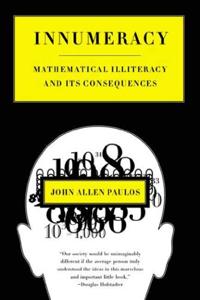
Want to learn the ideas in Innumeracy better than ever? Read the world’s #1 book summary of Innumeracy by John Allen Paulo here.
Read a brief 1-Page Summary or watch video summaries curated by our expert team. Note: this book guide is not affiliated with or endorsed by the publisher or author, and we always encourage you to purchase and read the full book.
Video Summaries of Innumeracy
We’ve scoured the Internet for the very best videos on Innumeracy, from high-quality videos summaries to interviews or commentary by John Allen Paulo.
1-Page Summary of Innumeracy
Overview
Mathematics can be tough to learn, especially for those who struggled with it in school. Many people have a fear of math and avoid it altogether because they don’t understand how to make sense of numbers.
In our society, you can say that math is not your strong suit and that you’re not a numbers person. But if someone doesn’t understand the basic concepts of numbers, they’re innumerate—and this isn’t a minor issue.
In this article, you’ll learn about the problem of innumeracy and how it can affect people’s lives. You’ll see how a basic understanding of math can be extremely beneficial to you in many situations.
You will also learn how many clothes a person can wear if they own 5 shirts and 3 pairs of pants. Also, you’ll learn why blond women with ponytails are common in Los Angeles, as well as why astrology is pseudoscience.
Big Idea #1: Innumerate people have trouble grasping basic mathematical principles and often fail to react appropriately to everyday events.
People rarely admit they are illiterate, but it’s quite common for people to say that math was their worst subject.
But being innumerate is nothing to be proud of.
Being innumerate has a number of negative consequences, one being an inability to react appropriately in situations involving numbers. If you are unable to determine if something is big or small, you may be inclined to personalize the issue when your own experience biases your view of the situation.
For example, the probability of being attacked by an alligator is low. However, someone who lacks mathematical skills may develop a fear of alligators after reading about such an attack in the news, even though that person knows that gator attacks are rare. Another negative effect of innumeracy is an inability to understand simple mathematical principles. For instance, anyone can multiply two numbers together and get a different result than multiplying their sum (2 x 3 = 6 vs 2 + 3 = 5).
To apply this concept to a real life situation, we can use it to figure out how many outfits someone has in their closet.
Going even further, we would then conclude that if the woman were to plan her outfits for an entire week, she would have 15 choices on day one and 14 choices on day two. This pattern continues until she has only a single choice left. If this is done for a whole week, there will be 15⁷ – or 170,859,375 different options!
Some people, though, might not understand the number of shirts and pants that would be needed to reach a certain amount. They might think it’s ridiculous that such a large number could come from so few items of clothing.
Big Idea #2: Innumerate people tend to misunderstand the concept of coincidences, which are improbable, yet common, events.
Christopher Columbus discovered the New World in 1492. Enrico Fermi, who discovered the atom in 1942, was born on September 29th of that year. Sigmund Freud, a famous psychoanalyst and founder of psychoanalysis claimed that there is no such thing as coincidence. Famous psychoanalysts have been known to study coincidences because they’re not just random events; instead, they actually happen quite often.
The high occurrence of coincidences is an established fact. For example, in 1964, a blond woman with a ponytail stole a purse and drove off in a yellow car driven by a black man with facial hair.
The police brought in two suspects who matched the description of the crime. The court, however, argued that there were many other couples in LA with similar looks and therefore it was not likely that these particular people committed the crime.





